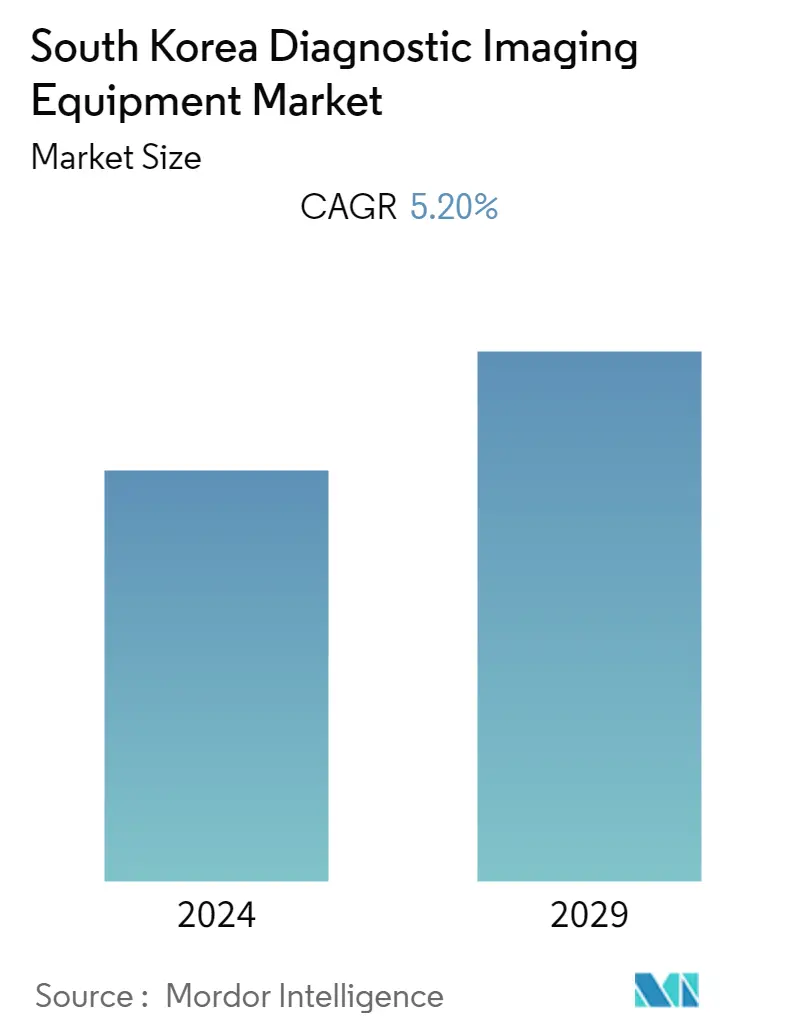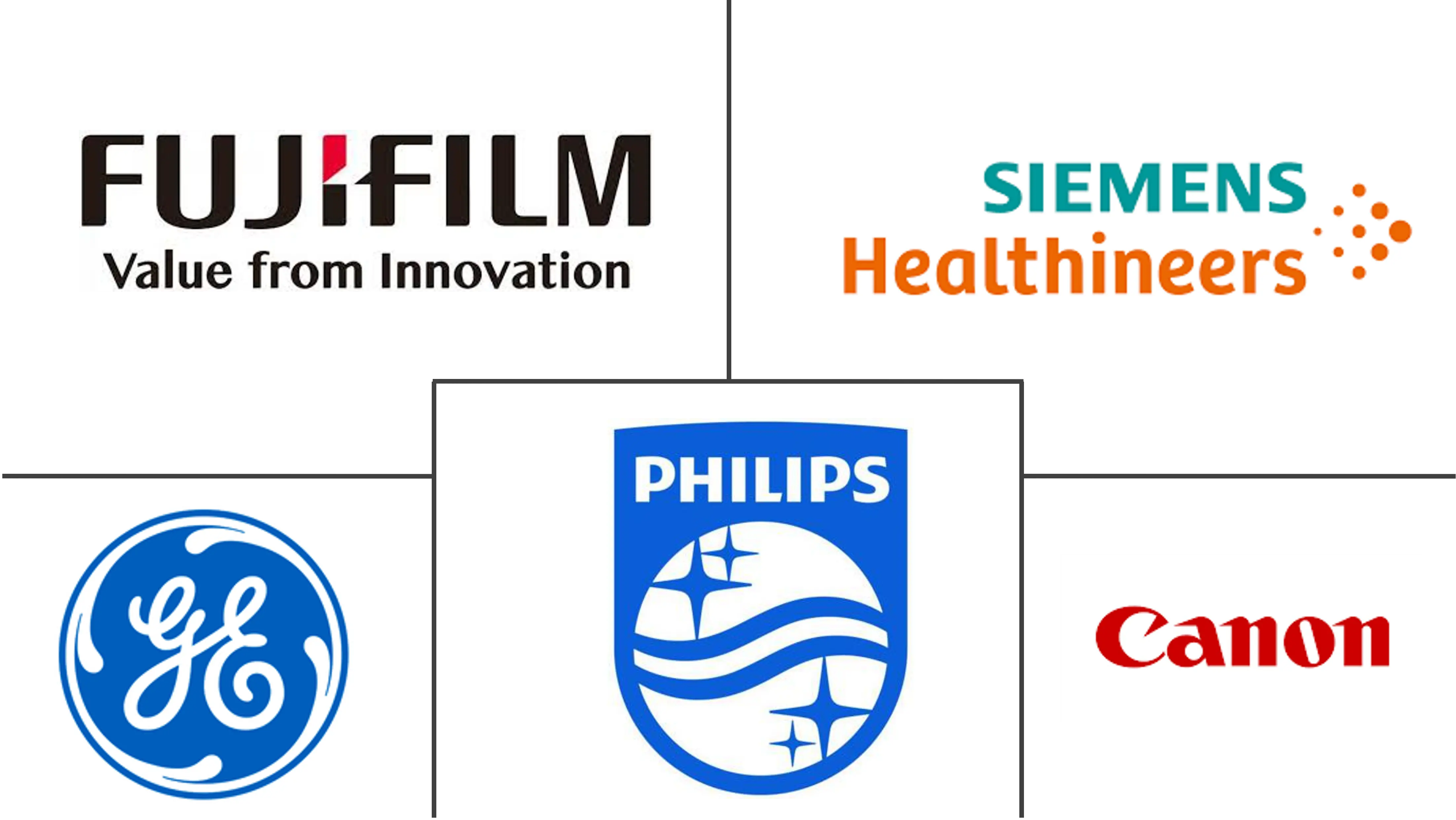Market Size of South Korea Diagnostic Imaging Equipment Industry

| Study Period | 2019 - 2029 |
| Base Year For Estimation | 2023 |
| Forecast Data Period | 2024 - 2029 |
| Historical Data Period | 2019 - 2022 |
| CAGR | 5.20 % |
Major Players
*Disclaimer: Major Players sorted in no particular order |
South Korea Diagnostic Imaging Market Analysis
The South Korea diagnostic imaging market is expected to register a CAGR of nearly 5.6% during the forecast period (2022-2027).
The COVID-19 pandemic is expected to have a significant impact on the market. The COVID-19 pandemic has an impact on the demand for imaging diagnostics, in view of the potential benefits, such as reduced exposition of healthcare workers to infected patients, repeatability during follow-up, low costs, and easier application in low-resource settings, which might have a slightly positive impact on the diagnostic imaging market.
The major factors driving the South Korean diagnostic imaging market include technological advancements, the increasing prevalence of chronic diseases, and the rising geriatric population.
As the burden of chronic diseases grows, the overall growth of the studied market is also expected to rise in South Korea. As per the article titled "Prediction of Cancer Incidence and Mortality in Korea, 2022" published in PubMed Central, in 2022, it was concluded that in Korea, 81,277 cancer deaths and 274,488 new cancer cases are anticipated to occur in the year 2022As Thus, the number of diseases requiring imaging procedures, also increases. New models for therapy and diagnoses are being developed, which provide precise results, help in early detection of diseases, and help minimize the cost of treating these diseases. New imaging techniques that reveal greater anatomical details are available in most of the diagnostic labs and hospitals, which makes imaging procedures accessible to older population for early detection of diseases.
Furthermore, there will be a huge demand for imaging services for diagnosing chronic conditions, therefore, launches by key players are the major factor contributing to the market growth. in March 2021, a South Korean company, DRTECH launched three new innovative products for general radiography and mammography imaging, AIDIA; premium full-field digital mammography system at Korea International Medical & Hospital Equipment Show (KIMES) 2021. The rising product launch in the country will positively impact the market growth. Thus, owing to the factors mentioned above, the studied market is expected to see robust growth.
South Korea Diagnostic Imaging Industry Segmentation
As per the scope of the report, the United States diagnostic imaging market covers diagnostic imaging used to take images of the internal structure of the human body using electromagnetic radiation, for accurate diagnosis of the patient. The South Korea Diagnostic Imaging Market is segmented by Product (X-ray, Ultrasound, Magnetic Resonance Imaging (MRI), Computed Tomography, Nuclear Medicine, Fluoroscope and Mammography), Application (Cardiology, Oncology, Neurology, Orthopedic, Gastroenterology, Gynecology and Other Applications), and End User (Hospitals, Diagnostic Centers and Other End Users). The report offers the value (in USD million) for the above segments.
| By Product | |
| X-ray | |
| Ultrasound | |
| Magnetic Resonance Imaging (MRI) | |
| Computed Tomography | |
| Nuclear Medicine | |
| Fluoroscope | |
| Mammography |
| By Application | |
| Cardiology | |
| Oncology | |
| Neurology | |
| Orthopedic | |
| Gastroenterology | |
| Gynecology | |
| Other Applications |
| By End User | |
| Hospitals | |
| Diagnostic Centers | |
| Other End Users |
South Korea Diagnostic Imaging Equipment Market Size Summary
The South Korean diagnostic imaging equipment market is poised for significant growth, driven by technological advancements and an increasing prevalence of chronic diseases. The market is experiencing a positive impact from the COVID-19 pandemic, which has highlighted the benefits of imaging diagnostics, such as reduced exposure for healthcare workers and cost-effectiveness. The rising geriatric population further fuels demand, as new imaging techniques and models for therapy and diagnosis enhance early disease detection and treatment cost efficiency. The market is characterized by robust product launches, such as DRTECH's introduction of innovative imaging products, which contribute to the market's expansion. The MRI segment, in particular, is set to dominate due to its safety and technological advancements, with South Korea leading in MRI usage compared to OECD averages.
The competitive landscape of the South Korean diagnostic imaging market is moderately concentrated, with major players like GE Healthcare, Canon, Siemens Healthineers, Koninklijke Philips NV, and FUJIFILM Holdings Corporation holding significant market shares. These companies are heavily investing in research and development to create advanced products that minimize costs and side effects. The high barriers to entry in the industry limit new competitors, allowing established players to maintain their dominance. Recent developments, such as the launch of high-performance ultrasound systems and partnerships for enhanced MRI technology, underscore the dynamic nature of the market. Imaging plays a crucial role in cancer detection and treatment, further driving market growth as cancer remains a leading cause of morbidity and mortality in Korea.
South Korea Diagnostic Imaging Equipment Market Size - Table of Contents
-
1. MARKET DYNAMICS
-
1.1 Market Overview
-
1.2 Market Drivers
-
1.2.1 Increasing Prevalence of Chronic Diseases and Rising Geriatric Population
-
1.2.2 Technological Advancements and Rapid Innovation
-
-
1.3 Market Restraints
-
1.3.1 Side Effects of Diagnostic Imaging Procedures
-
-
1.4 Porter's Five Forces Analysis
-
1.4.1 Threat of New Entrants
-
1.4.2 Bargaining Power of Buyers/Consumers
-
1.4.3 Bargaining Power of Suppliers
-
1.4.4 Threat of Substitute Products
-
1.4.5 Intensity of Competitive Rivalry
-
-
-
2. MARKET SEGMENTATION (Market Size by Value - USD million)
-
2.1 By Product
-
2.1.1 X-ray
-
2.1.2 Ultrasound
-
2.1.3 Magnetic Resonance Imaging (MRI)
-
2.1.4 Computed Tomography
-
2.1.5 Nuclear Medicine
-
2.1.6 Fluoroscope
-
2.1.7 Mammography
-
-
2.2 By Application
-
2.2.1 Cardiology
-
2.2.2 Oncology
-
2.2.3 Neurology
-
2.2.4 Orthopedic
-
2.2.5 Gastroenterology
-
2.2.6 Gynecology
-
2.2.7 Other Applications
-
-
2.3 By End User
-
2.3.1 Hospitals
-
2.3.2 Diagnostic Centers
-
2.3.3 Other End Users
-
-
South Korea Diagnostic Imaging Equipment Market Size FAQs
What is the current South Korea Diagnostic Imaging Equipment Market size?
The South Korea Diagnostic Imaging Equipment Market is projected to register a CAGR of 5.20% during the forecast period (2024-2029)
Who are the key players in South Korea Diagnostic Imaging Equipment Market?
FUJIFILM Holding Corporation, GE Healthcare, Koninklijke Philips N.V, Siemens Healthineers and Canon Inc. are the major companies operating in the South Korea Diagnostic Imaging Equipment Market.

